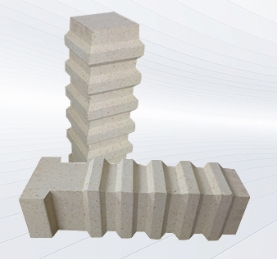- 16
- Sep
Anchor brick
Anchor brick

Product advantages: high strength, good erosion resistance, high peeling resistance.
Product application: It plays the role of skeleton connection in the pouring of castables.
ကုန်ပစ္စည်းအကြောင်းအရာ
Anchor bricks are also called hanging bricks. They are made of raw materials, press-formed or poured, and then sintered at high temperature. The alumina content of anchor bricks is more than 55%, and the alumina content of anchor bricks can reach 75%. The load softening temperature of this type of brick body reaches 1550 ℃, which is an excellent refractory brick product. However, in general, the alumina content of 55% is selected because the anchor bricks with 55% content are more flexible. Anchor bricks play an important role in the construction of straight facing walls, which can improve the integrity of the straight facing walls.
In addition, it should be noted that anchor bricks are used to anchor refractory castables. The properties of anchor bricks should be consistent with the castable material, and the expansion and contraction should be consistent, so as to form a close combination with the castable and extend the life of the furnace lining. The anchor brick is a new type of anchor brick used in industrial furnaces, in particular, it relates to an anchor brick used in industrial furnace roof. A groove is provided with ribs along the length direction on at least one surface of the anchor body. After the ribs are installed, due to the reinforcement and pulling action of the ribs, the tensile and flexural strength of the anchor solid is significantly improved, and the stress generated at the groove Obstructed at the ribs can not continue to pass, so the anchor bricks of this kind of structure are not easy to break.
The layout and masonry of anchor bricks during use should follow the following principles:
1. The arrangement of anchoring bricks should be determined according to the range and frequency of temperature changes and the size of the direct wall area, usually not less than 6 blocks/m2.
2. Check the anchor bricks carefully before building. If the anchor bricks have cracks in the anchor holes that affect the overall strength of the anchor bricks, they should not be used and should be resolutely discarded.
3. When the masonry is close to the anchoring brick position, the bricks should be arranged in advance to determine the exact position of the anchoring brick. The welding part of the metal shell is cleaned with a wire brush. The welding rod is used for the welding parts, and the welding is firm. Anchor the tube.
4. After the anchoring bricks are built, insert the anchoring hook, and fill the airstrike with refractory fiber felt and plug it tightly to form a certain degree of protection for the anchors.
ရုပ်ပိုင်းဆိုင်ရာနှင့်ဓာတုညွှန်းကိန်းများ
| အဆင့်/အညွှန်း | မြင့် alumina အုတ် | အလယ်တန်းမြင့် alumina အုတ် | အဆင့်သုံး alumina အုတ် | အလွန်မြင့်မားသော alumina အုတ် |
| LZ-75 | LZ-65 | LZ-55 | LZ-80 | |
| AL203 | 75 | 65 | 55 | 80 |
| Fe203% | 2.5 | 2.5 | 2.6 | 2.0 |
| သိပ်သည်းဆ g / cm2 | 2.5 | 2.4 | 2.2 | 2.7 |
| အခန်းအပူချိန် MPa> တွင်ဖိအားခံနိုင်ရည်ရှိသည် | 70 | 60 | 50 | 80 |
| ပျော့ပြောင်းသည့်အပူချိန်ကို C သို့တင်ပါ | 1520 | 1480 | 1420 | 1530 |
| Refractoriness ° C> ဖြစ်သည် | 1790 | 1770 | 1770 | 1790 |
| သိသာမြင်သာမှုရာခိုင်နှုန်း | 24 | 24 | 26 | 22 |
| အပူလိုင်းအမြဲတမ်းနှုန်းပြောင်းနှုန်း | -0.3 | -0.4 | -0.4 | -0.2 |
